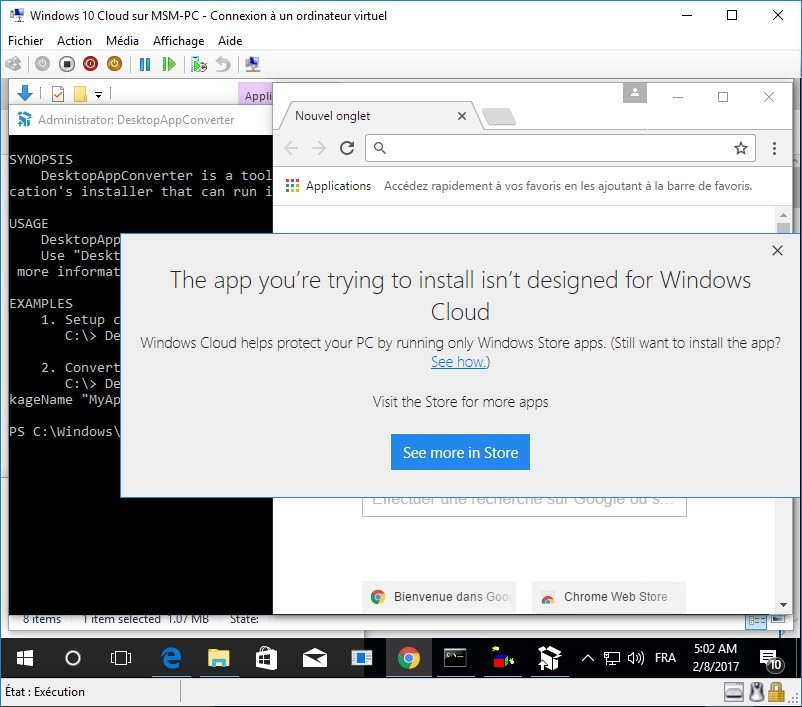With most desktop environments, run a Windows program with WINE by right-clicking the file and choosing Open with WINE program loader. Or, run the program from the command line using the following command. With the Windows 10 May 2020 Update (aka Windows 10 version 2004), you can reinstall Windows from the cloud as an alternative to a local reinstallation. As this option downloads a fresh copy of. Adobe Creative Cloud runs well on a wide range of Windows 10 PCs, but if you're specifically looking for something with it in mind, then you're obviously going to want something that will really. Build Cloud Run data processing applications that transform lightweight data as it arrives and store it as structured data. Transformations can be triggered from Google Cloud sources. When a.csv file is created, an event is fired and delivered to a Cloud Run. How to Safely Run Software With Windows 10 Sandbox. Windows Sandbox is a temporary virtual machine built into Windows 10 that allows you to run software without it affecting the rest of your. Largest portable hard drive.
What is a virtual machine (VM)?
A virtual machine is a virtual representation, or emulation, of a physical computer. They are often referred to as a guest while the physical machine they run on is referred to as the host.
Virtualization makes it possible to create multiple virtual machines, each with their own operating system (OS) and applications, on a single physical machine. A VM cannot interact directly with a physical computer. Bluestacks for windows mobile. Instead, it needs a lightweight software layer called a hypervisor to coordinate between it and the underlying physical hardware. The hypervisor allocates physical computing resources—such as processors, memory, and storage—to each VM. It keeps each VM separate from others so they don't interfere with each other.
While this technology can go by many names, including virtual server, virtual server instance (VSI) and virtual private server (VPS), this article will simply refer to them as virtual machines.
How virtualization works
When a hypervisor is used on a physical computer or server, (also known as bare metal server), it allows the physical computer to separate its operating system and applications from its hardware. Then, it can divide itself into several independent 'virtual machines.'
Each of these new virtual machines can then run their own operating systems and applications independently while still sharing the original resources from the bare metal server, which the hypervisor manages. Those resources include memory, RAM, storage, etc. Logic pro x 10 1 professional music production.
The following video explains the basics of virtualization (5:20) and check out the article, '5 Benefits of Virtualization':

Storing secure information such as a password or a certificate on a device couldmake a device vulnerable to exposure. A leaked password is a sure fire way tocompromise the security of a device or an entire system. In the Windows family,the technology that supports the security of the OS is the Trusted Platform Module.
A Trusted Platform Module (TPM) device is a microcontroller that can store data and perform computations. It can be either a discrete chip soldered to a computer'smotherboard or a module integrated into the system on a chip (SoC) by the manufacturer.
Inside the TPM
A key capability of the TPM is its write-only memory. Based on the data in it,TPM can also compute a cryptographic hash (such as the HMAC), based on that data.It's impossible to uncover the secret given the hash, but if the secret is knownto both parties of communication, it is possible to determine whether the hashreceived from another party was produced from that secret.
The basic idea behind using cryptographic keys: the secret (also called theshared access key) is established and shared between the IoT device and thecloud during the device provisioning process. From that point on, an HMACderived from the secret will be used to authenticate the IoT device.
Device Provisioning
The provisioning tool for Windows 10 IoT Core devices is called the IoT CoreDashboard and it can be downloaded and configured easily.
The dashboard produces an image of the OS and securely connects your device toAzure. This is done by associating the physical device with the device ID in the Azure IoT Huband imprinting the device-specific shared access key to the device's TPM.
For devices that don't have a TPM chip, the tool can install a software-emulatedTPM. This does not provide security but allows you to develop your appusing a maker device (such as Raspberry Pi 2 or 3) and have security 'light up'on a device with the hardware TPM without having to change the app.
Run Windows Programs In The Cloud Computing
To connect your device to Azure, click on the 'Connect to Azure' tab:
You will be asked to log in to your Azure account. Pick the desired instance ofAzure IoT Hub and associate your physical device with it. If you don't have anyIoT Hub instances in your Azure subscription, the tool will let you create afree instance.
Once you have selected the IoT Hub and the device ID to associate your devicewith, you can imprint the shared access key of that device on your TPM:
Your device is now ready to connect to Azure in a secure way.
You can also use the Windows Device Portal to dynamically acquire an IoT Hub connection string when it first connects to the internet after being provisioned. This can be done from the 'Azure Clients' tab in the Device Portal.

